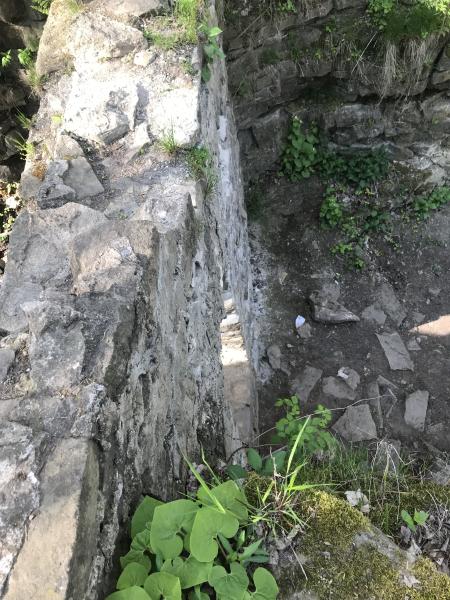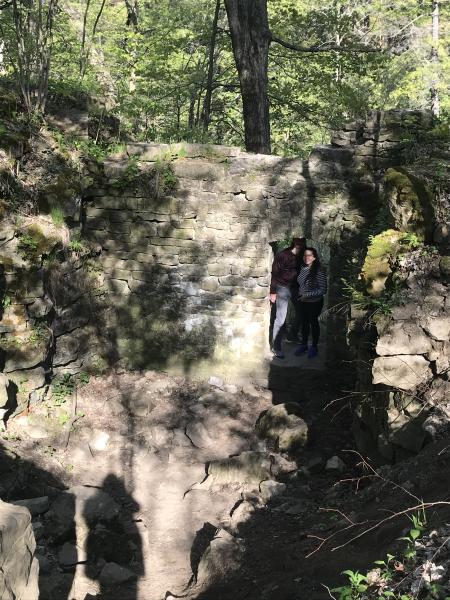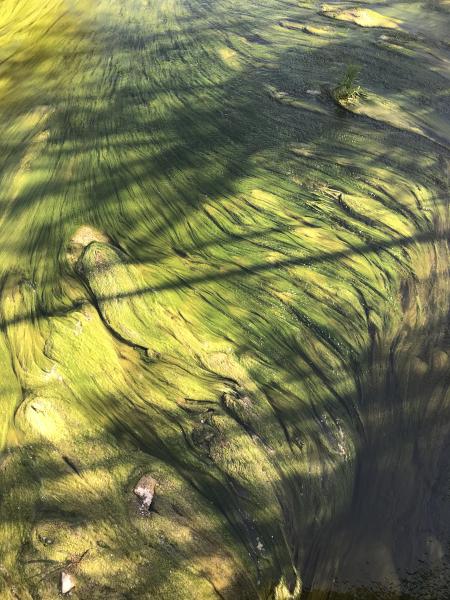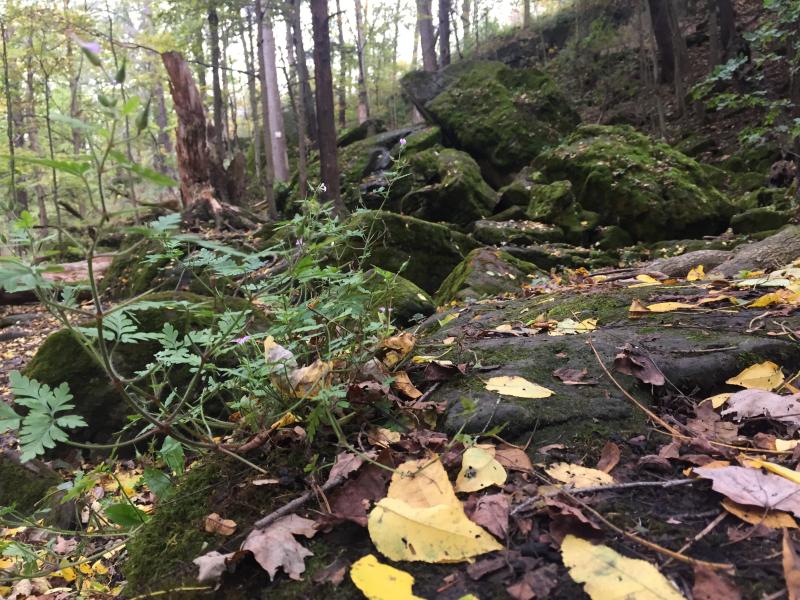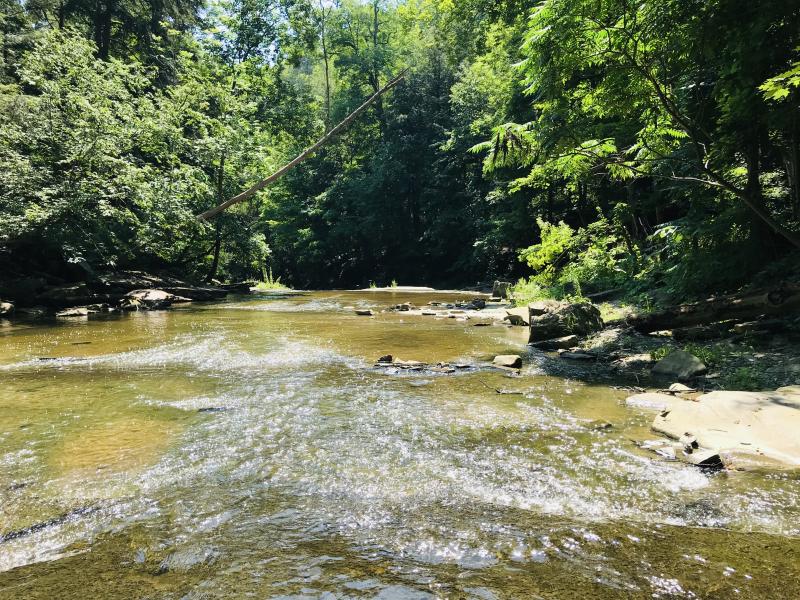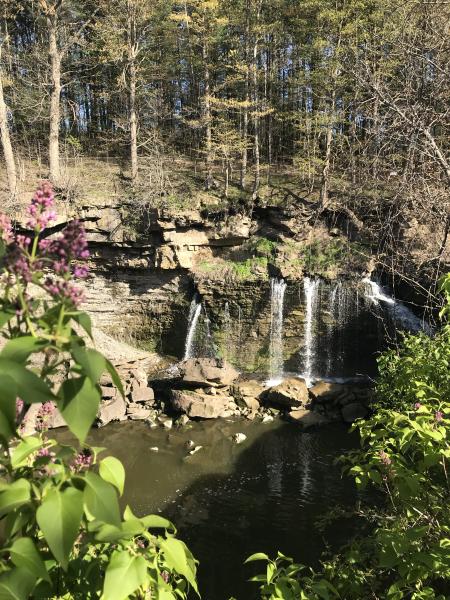
Sha’tetyonatnekí:non “Waters of the Same Source”
Bikwaakwadoon Gaagiidjiwan
Location
GPS Coordinates
Ball’s Falls is an 80-hectare park that sits on two important landscape features: the Niagara section of the Niagara escarpment and the Twenty Mile Creek valley. Managed by the Niagara Region Conservation Authority, Ball’s Falls encompasses forests, two waterfalls, an arboretum, and preserved historical buildings, all connected by a trail system. At the main entrance, there is also a renovated Centre for Conservation building that houses educational galleries and displays that highlight the natural and heritage significance of the Niagara region.
Ball’s Falls lies in the Carolinian forest zone and is composed of rich deciduous and mixed-wood forests. Sugar maple- and beech-dominant deciduous forests are common. In these forest types, the dominant species are interspersed with bitternut hickory and basswood, with dogwoods, ash and red flowering raspberries in the understory. Twenty Mile Creek, which flows through the conservation area, provides moisture for water loving understory plant species, such as jewelweed, sedges, and lady fern.
The slopes of the Twenty Mile Creek valley are favored by hemlock, which forms the canopy dominant in mixed forests. Hemlocks are accompanied by hickories, red oak, black walnut, and black maple in the canopy, and dogwood, red elder and mountain maple in the shrub layer. Canada mayflower, wild ginger, false solomon seal, and mayapple often grow together under a hemlock canopy. Alyssa General from Six Nations characterizes the relationship between these plants as recognized within Haudenosaunee Ecological Knowledge. She shared at Balls Falls that when people look for Reishi mushrooms, they look for areas with hemlock trees, because this habitat is preferred by Reishi mushrooms, which grow on hemlocks.
Indigenous presence and occupation of the Twenty Mile Creek valley has been documented in the archaeological record dating back to 4000 BCE. The south-western shores of Lake Ontario was home to the Attiwandaron (Neutral) Nation. Archaeologists have documented Neutral villages and settlements dating from 900 BCE to 1500 CE around Lake Ontario. These include occupation at both the upper and lower falls in Ball’s Falls Conservation Area, and a series of villages north of Ball’s Falls, at the base of the Niagara escarpment. These villages show a pattern of downstream relocations along the Twenty Mile Creek valley over time.
From 1647 to 1651, the Attiwandaron (Neutral) nation suffered from epidemics brought over from Europe and subsequently dispersed and joined other nations. The Haudenosaunee moved into the area and continued to make use of the well-established footpaths and trail systems, including the Iroquois and Mohawk trails. These are two parallel long-distance trails that connect Niagara Falls to Hamilton Harbor. The Mohawk trail ran along the top of the Niagara escarpment, while the Iroquois trail ran along the bottom of the escarpment, and is the route of the Bruce trail and, after European settlers moved to the area, they used the trails which much more recently, became modern paved roads. For example in the nearby village of Jordan, King Street/Hwy 81 follows the original route of the Iroquois trail.
The village of Ball’s Falls, for which the conservation area derives its name, was founded in the 19th century by the Ball family. The Ball family were immigrants from Germany who initially settled in America. During the American revolutionary war, they fought on the side of the loyalists to the English crown and moved to Canada at the end of the war. The town developed around a series of mills. Currently preserved buildings include the original Ball family home, the grist mill, and a barn, lime kiln, and church.
The Ball’s Falls GeoTrail, found online at: https://storymaps.arcgis.com/stories/afaddabf2e7f4ddfa9617cc5b18bc88c
Ball's Falls Geotrail (arcgis.com)
The Canadian Archaeology Association Newsletter, “Fieldwork in Ontario,” pp- 22 – 28, found online at: https://canadianarchaeology.com/caa/system/files/publications/caa-newsletter/2001/newsletter21-1.pdf
Johnson, Lorraine. 2007. The Natural Treasures of Carolinian Canada: Discovering the Rich Natural Diversity of Ontario’s Southwestern Heartland. Carolinian Canada Coalition.
Kelly, Peter E. and Larson, Doug. 2007. The Last Stand: A Journey Through the Ancient Cliff-face Forest of the Niagara Escarpment. Natural Heritage Books.
| English | Latin | Kanienʼkéha | Anishinaabemowin |
|---|---|---|---|
| Wild Ginger | Asarum canadense | tsyonehskwénrye | namepin, nmepin |
| Bitternut Hickory | Carya cordiformis | o’nón:na, ontsí:kahwe, yohso'kwatskà:rat | mitigwaabaak (-ook, plural) |
| Running Strawberry-bush | Euonymus obovatus | (check this) | (check this) |
| Green Ash | Fraxinus pennsylvanica | kaneróhon | emikwaansaak, aagimaak, bwoyaak |
| Sugar Maple | Acer saccharum | wáhta’, ohwáhta | ininaatik, ininaatig (-oog, plural) |
| Mountain Maple | Acer spicatum | (check this) | zhaashaagobiimag |
| Red Baneberry | Actaea rubra | onekwénhtara niwahyò:ten, orá:tu | memskwagenagodeg, wi’cosidji’bik |
| Jack-in-the-pulpit | Arisaema triphyllum | tyehnónhserote, kyehnónserote, kárhon, tsyorákares, tsorákares, kahnéhserote, okwá:rot nikarhonksherá:'a | zhaashaagomin |
| Wild Ginger | Asarum canadense | tsyonehskwénrye | namepin, nmepin |
| Lady Fern | Athyrium felix-femina | yetskarónhkwa | a' sawan, naanaaganashk (-oon), mzise miijim |
| Pepper root | Cardamine diphylla (Michx.) Alph. Wood | à:tsya | waasganjiibik |
| Bitternut Hickory | Carya cordiformis | o’nón:na, ontsí:kahwe, yohso'kwatskà:rat | mitigwaabaak (-ook, plural) |
| Blue Cohosh | Caulophyllum thalictroides | karhakón:ha, kahrhatakon | kwemshkiki, be'cigodji'bigak, bezhigojiibik, zhiigimewibag |
| Alternate-leaf Dogwood | Cornus alternifolia | teyotsí:tsayen | moozwemizh, moozomizh, niibiishan miskwaabiimizhiig |
| Mountain Wood Fern | Dryopteris campyloptera | yetskarónhkwa, onitskerónhkwa, yetskaronhkwa'kó:wa | naanaaganashk (-oon), mzise miijim |
| Spinulose Wood Fern | Dryopteris carthusiana | yetskarónhkwa, onitskerónhkwa, yetskaronhkwa'kó:wa | naanaaganashk (-oon), mzise miijim |
| Intermediate Wood Fern | Dryopteris intermedia | yetskarónhkwa, onitskerónhkwa, yetskaronhkwa'kó:wa | naanaaganashk (-oon), mzise miijim |
| Marginal Wood Fern | Dryopteris marginalis | yetskarónhkwa, onitskerónhkwa, yetskaronhkwa'kó:wa | naanaaganashk (-oon), mzise miijim |
| Broad-leaved Helleborine | Epipactis helleborine | (check this) | (check this) |
| Trout Lily | Erythronium americanum | skatsihstóhkonte | namegbagoniin |
| Running Strawberry-bush | Euonymus obovatus | (check this) | (check this) |
| Large-leaved Aster | Eurybia macrophylla | teyonerahtawe'éhston, orón:ya yotiron’onhkóhare, iotsiron'onhkóhare oròn:ia, yako’tonhkwárhos onónhkwa, iako'tonhkwáhrhos onónhkwa | migiziwibag |
| American Beech | Fagus grandifolia | yotyentatí:wen | gawe’mic, sewe-miins |
| Green Ash | Fraxinus pennsylvanica | kaneróhon | emikwaansaak, aagimaak, bwoyaak |
| Pale Jewelweed | Impatiens pallida | ietsi'erorókhstha, yetsi'erorókhstha | gzhiibosegaateaa, omakakiibag |
| Black Walnut | Juglans nigra | tsyohsò:kwak | bagaanaak |
| False Solomon’s Seal | Maianthemum racemosum | kítkit o'éta | agongseminan, agongosimizh, agong’osiminan |
| Common Yellow Woodsorrel | Oxalis stricta | teyoratu teyorá:ton | ziiwanabagashk |
| Virginia Creeper | Parthenocissus quinquefolia | kontiráthens | mnidoo- biimaakwad bebaamooded |
| Mayapple | Podophyllum peltatum L. | onénhotst, onénhotste, kawérhos | zhaabozigan (-an, plural), ininiwijiibik |
| Red Oak | Quercus rubra | karíhton | miskode-miizhmizh, mitig mewish (-iik plural) |
| Prickly Gooseberry | Ribes cynosbati | tyorenatsí:yo, ohrá:ton, anáduma:o:náhi | zhaabo-miinashkoon, zhaaboomin (-aak, plural), me’skwacabo’minak, kaawe-saba, Zhaaboominagaawanzh/iig "going through/piercing berr plant/s or shrub/s" |
| Red Raspberry | Rubus idaeus | skanekwen’terá:yen, skanekwen’terá:ne, skanekwenhtará:nenh | miskomin (-ak, plural) |
| Purple Flowering Raspberry | Rubus odoratus | ahtahkwakáyu, ahtahkwaká:yon | miskomin (-ak, plural) |
| Red Elderberry | Sambucus racemosa | ahrhakéha | papashkisiganak (-oon, plural) |
| Bloodroot | Sanguinaria canadensis | tekanekwas, tekané:kwaks, tekanekwénhshya'ks | miskwi- chiibikoon |
| Canada Goldenrod | Solidago canadensis | otsí:nekwar niyotsi’tsyò:ten | ajidamoowaanow, waabanoominens/waabanoominensag, giizisso mashkiaki |
| Zig-zag Goldenrod | Solidago flexicaulis | otsí:nekwar niyotsi’tsyò:ten | ajidamoowaanow, waabanoominens/waabanoominensag, giizisso mashkiaki |
| Calico Aster | Symphyotrichum lateriflorum | teyonerahtawe'éhston, yotsiron’onhkóhare orón:ya | name'gosiibag |
| Dandelion | Taraxacum officinale | tekaronhyaká:nere | mindemoyanag, doodooshaaboojiibik, mindimooyenh, wezaawaaskwaneg |
| Canada Yew | Taxus canadensis | onn’tyón:ni | ne'bagandak |
| Basswood | Tilia americana | ohóhsera | wiigobiish, wiigob, wiigobiig (plural) |
| Poison Ivy | Toxicodendron radicans | yakohón:taras, yakohontaráhstha, wate’nenharì:sere, yakohén:tara’s | nimkiibak |
| Red Trillium | Trillium erectum | tsyonà:tsya onekwénhtara niyotsi’tsyò:ten, áhsen niioneráhtonte | moonigohn, ininiiwindibiigegan, ini'niwin'digige'gun |
| White Trillium | Trillium grandiflorum | tsyonatsyakén:ra niyotsi’tsyò:ten, tsyoná:tsik, áhsen niioneráhtonte | ininiiwindibiigegan, baashkindjibgwaan, baushkindjibgwaun, ini'niwin'digige'gun |
| Eastern Hemlock | Tsuga canadensis | onen’ta’ón:we | gaagaaimizh, baagoodag, mitg, gaagaagiwa/inzh |
| Downy Yellow Violet | Viola pubescens | tekonnyarotárhoks, tekonteniarotáhrhoks, tewatenyarotárhos | we-waawiyeyaa-bagak, wewaie’bagag |
